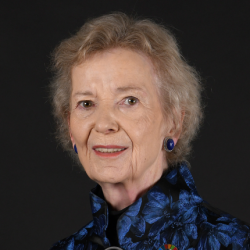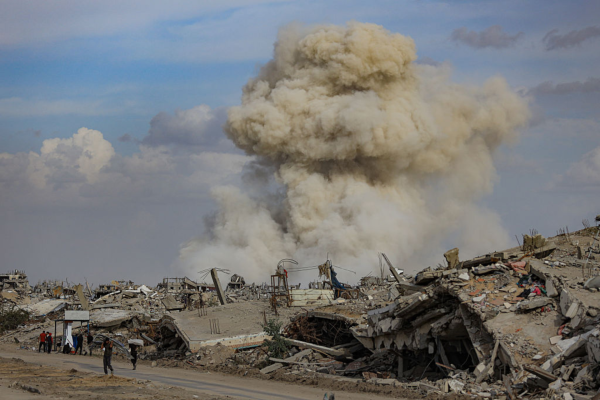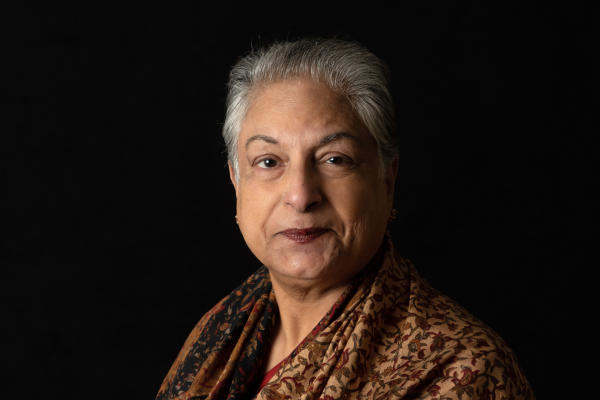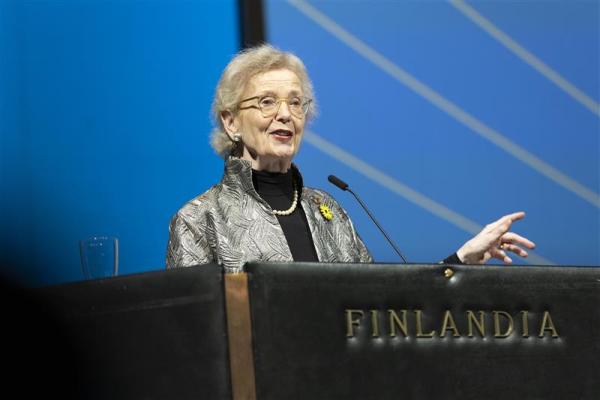Climate, Nature, and Conflict: The unspoken interactions that require urgent actions

Excellencies, Ladies and Gentlemen,
It is an honour to speak to you today on the most timely but complex topic of climate, nature and conflict. When I received the invitation, I was very pleased to see that this topic had been chosen as the theme for this central plenary of the annual conference of the European Consortium on Political Research.
I am speaking this afternoon in my capacity as Chair of The Elders, the group of independent global leaders founded by Nelson Mandela in 2007 who work for peace, justice, human rights and a sustainable planet, and also as an angry granny!
For us Elders, these goals are indivisible. They were articulated succinctly last year by my fellow Elder Juan Manuel Santos, the former President of Colombia and Nobel Peace Laureate, when he addressed the UN Security Council on the need for humanity to “make peace with nature”.
He challenged those in the Council who wish to treat climate and conflict as separate issues, noting that in the real world, the consequences of climate change and conflict very clearly converge. He put it simply, but clearly: “There cannot be peace without sustainable development, and there cannot be sustainable development without peace.”
Too often in my experience, the climate and nature crisis and conflict are placed in two different silos, and the political research undertaken on each rarely engages with the other.
Yet any rational observer contemplating the interlocked crises afflicting our world can see the linkages and the need for a holistic approach to both by policymakers and politicians, guided by the principles of justice, sustainability and universal human rights.
This is why I have long used the concept of climate justice to inform and guide my work on these issues, and I believe it is an intersectional framing that can help your own work as academics and researchers.
There are five key layers to climate justice:
-
Firstly, it recognises that the climate and nature crisis disproportionately affects the poorest countries, poorest communities, small island states and indigenous peoples of our planet;
-
Secondly, within that, it exacerbates gender injustice. Women are too often excluded from and oppressed by decision-making bodies and institutions, meaning their perspectives are not heard when climate policies are debated – yet it is also women who are the ones building resilience in their communities;
-
Thirdly, there is the intergenerational injustice whereby young people and those not yet born may suffer the physical, material and psychological consequences of a wrecked climate because of the actions – and inaction – of their predecessors;
-
The fourth injustice is a subtle one. Industrialised countries built their economies on fossil fuel. Now our challenge is to wean ourselves off coal, oil and gas far more quickly than we’re doing and to provide a just transition for the workers that helped us to build our economies. And we need to support developing countries to bring themselves out of poverty in ways that help them to move to renewable energy but understand the immediate need to address energy poverty with an equitable transition.
-
Lastly, there is the injustice to nature herself. The oceans, forests, ice shelves and coral reefs that predate human existence and help sustain it today are at risk from our reckless behaviour, as is the wildlife with whom we share this planet.
Taken together, these different layers of injustice mean we are faced with the simultaneous occurrence of multiple, interconnected crises that compound each other's effects.
The only way to tackle these crises is through cooperation, solidarity, collaborative governance and innovative problem-solving. We must insist our leaders take this pathway, as the only option for a sustainable future.
In my remarks tonight, I will highlight what I see as the most consequential linkages between conflict and the climate and nature crisis, and the type of change in political leadership required to effectively tackle these twin threats to planetary peace and sustainability.
One of the starkest recent examples of the impact of conflict on the environment, and the need for a principled multilateral response, is Russia’s war on Ukraine.
For the past two years, I have served alongside an esteemed group of international experts, led by former Swedish Foreign Minister Margot Wallström and also including Greta Thunberg, on a High Level Working Group on the Environmental Consequences of the War in Ukraine. This group was established by President Zelenskyy to document the crimes against the environment that are part of Russia’s war of aggression, but also to plan for a green recovery.
It has been a sobering journey, including two separate visits by train to Kyiv last year. We learned of the impact of the conflict on the Ukraine’s environment, ranging from the contamination of one third of its territory with landmines and unexploded ordinance, to the pollution of soils, waterways and forests from the impacts of shelling, fires and floods.
The most egregious example was the destruction of the Kakhovka dam in June 2023, presumed to be an intentional act by occupying Russian forces, which flooded villages and farmlands across a huge area.
The impacts go well beyond Ukraine; one analysis equates the greenhouse gas emissions from 12 months of the conflict as being equivalent to the emissions of a country the size of Belgium.
Another example with which we are confronted every day is Israel’s assault on Gaza following the horrific Hamas terrorist attacks of 7 October.
The death toll of nearly 40,000 Palestinians is appalling enough, but we have also seen the complete degradation of the soil, water, land, agriculture and built environment of the Gaza Strip, home to over two million people. The damage wrought to Gaza’s environment will be felt for years and decades hence.
Beyond individual examples, we are also gaining an increasing understanding of the complex, but very real, structural affect that the climate and nature crisis is having on conflict globally.
Changes in climate that affect livelihoods and living conditions, from rising sea waters to desertification and destruction of arable land, lead inevitably to changes and tensions that can directly increase the risk of violence and conflict.
This is particularly true in contexts with high levels of employment in traditional agriculture and limited alternative livelihoods, for example across the Sahel and Central Africa. Very often the communities affected are those least responsible globally for climate change, yet their rights to a healthy environment are being denied on an increasingly existential scale.
While the world adapts to the new realities brought about by the climate crisis, some of the materials on which a green energy transition depends are drawn from the most insecure environments on the planet. Cobalt and coltan, essential for the rechargeable batteries in many of the devices we all carry, and increasingly those we drive, are sourced in the east of the Democratic Republic of Congo, where rival groups – some supported by Rwanda - vie for control of valuable mining sites in a bloody conflict.
Patriarchal oppression and gender inequalities mean that women and girls are most disproportionately exposed to both the impacts of climate change and the worst effects of conflict, whatever its root causes. We see this with the continued prevalence of conflict-related sexual violence. A recent Human Rights Watch report documented horrific abuse in Sudan, but sexual violence remains a feature of conflict across the globe .
None of this can be dismissed as inevitable, or as situations for whom no-one can be held accountable. It is an imperative of both climate justice and conflict resolution that people are held responsible for their actions and inactions.
When we look at conflict-affected contexts, we see both a disproportionate vulnerability to climate impacts – think of the agriculturally dependent communities across the fragile societies that cover the Sahel and Central Africa – and a lack of the national and local institutional mechanisms needed to prepare for and adapt to climate change.
The international multilateral architecture is, regrettably, failing to meet this challenge. This is a political, moral and financial injustice.
Conflict-affected countries are receiving small fractions of climate financing, per capita, when compared to countries at peace. A UNDP study found that fragile states received just $10.80 per person in financing compared with $161.70 per person for non-fragile states.
Financing to the most fragile countries is too often in loans and not grants, which further increases their unsustainable debt. ‘Bankability’ of projects relies on criteria that ignore the reality of these contexts, and can lead to maladaptation and the burdening of already strained governance systems.
While the barriers to investing in conflict contexts are in one sense obvious – instability and violence always hinder both public and private investment - the International Financial Institutions and funding mechanisms need to step up to this challenge.
Creative approaches to manage the risk profiles of these contexts need to be found, while also developing projects that are attuned to the contextual needs. Large infrastructure investments in fragile contexts are understandably difficult to finance, but these communities are also hugely under-served by information and early-warning systems. These do not require large infrastructure, but can be invaluable for adaptation to climate trends.
The international financing system will never adequately address the climate and nature crisis as long as it neglects these contexts and the communities therein.
However, it is also fair to note that we have seen some progress of late in integrating climate, nature and conflict within the relevant global policy frameworks and institutions.
While there is still some opposition to the UN Security Council addressing the climate and nature crisis, there is growing consensus that these issues are inextricably intertwined.
The debates under UNFCCC that have tackled these intersections have included the “Climate Responses for Sustaining Peace” initiative at COP 27 and the Declaration on Climate, Relief, Recovery and Peace at COP 28. I hope we now have a firmly established space for this at all future COPs.
However, there are clear gaps. Emissions from military activities – both in maintaining militaries and actual engagement in conflict - were not fully covered by the 1997 Kyoto Protocol or the 2015 Paris Agreement, with states having reservations on the ground of national security concerns.
But according to a study by Scientists for Global Responsibility and the Conflict and Environment Observatory, militaries account for an estimated 5.5% of global greenhouse gas emissions
As has been said for other significant sources of emissions, like aviation and shipping, we cannot progress without properly accounting for these contributions.
We must also ensure that policy frameworks do not operate in isolation. As I noted, women are disproportionately affected by both the climate and nature crisis and conflict, but they are also the source of essential leadership to respond to both.
Women’s leadership under the Women Peace and Security agenda can be much better leveraged to address the climate and nature crisis in fragile and conflict affected settings. For example, funding support to women organisations in those settings, which is far behind the UN Secretary General’s target of 1% of Official Development Assistance, can greatly expand women’s agency in addressing these interlinked crises.
We also need to be wary of not creating new victims as we transition. The UN Secretary-General, in launching a panel on Critical Energy Transition Minerals, noted that growth in demand for critical minerals essential to a renewable energy revolution is set to increase by 3 and half times over the coming decade.
This represents an opportunity for the developing countries where these resources lie, but only if well managed. As Secretary-General Guterres said, “the race to net zero cannot trample over the poor.”
Nor can it ignore those living in fragile, conflict-afflicted societies. For example, in Myanmar we see that exports of rare earth materials are substantially increasing, while the country descends further into conflict.
Exports of minerals used in the renewable energy industries has increased since the military coup in 2021, while development indicators slide and local communities suffer the impacts of increased conflict. Greater regional and international cooperation is needed to ensure that these global supply chains do not exacerbate conflict.
At the heart of all these issues lies accountability.
Ukraine offers an example here for the world to follow. The Working Group on which I serve has produced an Environmental Compact, framed around 50 recommendations, which the Ukrainian Ministry of the Environmental Protection and Natural Resources is taking forward under a national action plan.
The Prosecutor General of Ukraine is to be commended for the action undertaken, during an ongoing defence of their country, to establish clear cases to prosecute crimes against the environment.
The Council of Europe has also established a Registry of Damage for Ukraine, as a first step towards holding the Russian Federation accountable for its actions in Ukraine.
In broader multilateral frameworks, progress is also being made to hold perpetrators to account.
The UN General Assembly recognised the need for full reparations for environmental damage due to wrongful acts in war in a 2022 resolution, and the UN Environment Assembly also passed a consensus resolution calling for better data collection in environmental damage during conflict.
The Rome Statute of the International Criminal Court (ICC) already holds the potential to prosecute such crimes, with Article 8 including attacks that cause “widespread, long-term and severe damage to the natural environment” as potential war crimes.
I welcomed the news earlier this year that the Chief Prosecutor of the ICC is developing a new policy paper on environmental crimes, and this will hopefully help to give this neglected element of the Rome Statute teeth. There is also growing recognition that a stronger defence of the environment is needed in law, and some calls for ‘Ecocide’ to be enshrined as an international crime.
The continued rise in climate change litigation is also encouraging, as citizens assert their rights and hold governments and corporations to account via the courts, including the recent case involving Swiss grannies at the European Court of Human Rights. The UN Environment Programme has tracked a steady increase in cases across many jurisdictions, including international and regional courts.
These legal issues are complex, but what is undisputed is that we need to continue to build stronger accountability mechanisms that both hold perpetrators to account and support the recovery of the environments and communities affected.
We need to translate these commitments into reality, if crimes against the environment are to be deterred and green recovery supported.
This is why my fellow Elders and I have been calling throughout this year for “long-view leadership” at all levels of society: internationally, nationally, regionally and locally.
The Elders have proposed five principles of long-view leadership. Decision-makers must consistently demonstrate the courage to:
-
Think beyond short-term political cycles and deliver solutions for both current and future generations.
-
Recognise that enduring answers require compromise and collaboration for the good of the whole world.
-
Show compassion for all people, designing sustainable policies which respect that everyone is born free and equal in dignity and rights.
-
Uphold the international rule of law and accept that durable agreements require transparency and accountability.
-
Commit to a vision of hope in humanity’s shared future, not play to its divided past.
Addressing the complex interlinkages between climate, nature and conflict is impossible without taking this long-view leadership approach.
If we can embed these principles in public life, in our use and application of data and political research and in our commitment to multilateral diplomacy, I have every confidence that we will reach a more peaceful, sustainable and just future for all, no matter how daunting current challenges may seem.
Cross-border research and dialogue is essential to identify common interests, confound stereotypes and disinformation and lay the foundations for policy-making that is fit for purpose in the 21st century.
I commend you in your ongoing work and would remind you of the exhortation of Nelson Mandela: “it always seems impossible until it is done.”








